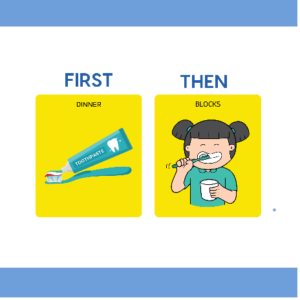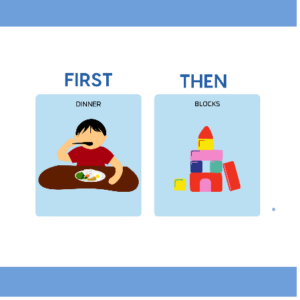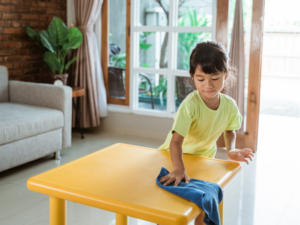A confident kid who becomes self-sufficient is what every parent hopes for their children. By encouraging independence, you can help gradually build their confidence and self-esteem, problem-solving skills, self-reliance, and self-efficacy. Independence and adaptive skills are often used interchangeably, but adaptive skills build confident kids who are independent. Adaptive skills are those everyday skills that enable children to function successfully in their environment without the assistance of their caregivers or other adults. These skills include self-care (e.g., hygiene, grooming), communication (e.g., expressive and comprehension), social interaction (e.g., sharing and cooperating with peers), and problem-solving abilities (e.g., asking questions).
Confident Kids Through Building Adaptive Skills
It can be tough to figure out where to begin teaching adaptive skills. As a parent, your instinct is to step in when your child is struggling, save them from their mistakes, and limit their familiarity with failure – this is normal!
Children are still developing their knowledge and understanding of the world in their early years. They also lack the necessary skills, knowledge, and experience to be fully independent in various tasks. Because of this, they will likely fail as they take on tasks independently. Let’s look at some adaptive skills you can use to help develop your confident kid.
Establishing Routines
Failure is part of the process of developing and mastering new skills. This is why it’s important that expectations for independence be age-appropriate and consider the child’s individual needs and abilities. Routines play an essential role in increasing independence in preschoolers. Establishing consistent routines helps children develop a sense of predictability and structure in their daily lives, gradually increasing their confidence to take on tasks independently.
Expectations for Adaptive Skills
It takes time, effort, modeling, and practice to grow your child’s independence. However, the outcome is rewarding for everyone involved! Below are some reasonable expectations of adaptive skills to encourage for children between the ages of 3 and 5:
Following simple instructions
Children aged 3-5 should be able to understand and follow simple instructions, such as “Put your shoes on” or “Come here.” By age 5, they may be able to follow more complex instructions, such as following a recipe or completing a craft project.
Dressing and undressing
By age 3, children should be able to start dressing themselves with some assistance; by age 5, they should be able to dress independently.
Feeding themselves
By age 3, children should be able to use utensils to feed themselves with some mess, and by age 5, they should be able to use utensils without assistance.
Cleaning up
Children aged 3-5 should be encouraged to clean up their own toys and belongings after playing with them. By age 5, they may be able to help with more complex household chores such as sweeping or folding laundry.
Communicating needs
Children aged 3-5 should be encouraged to express their needs and wants clearly and politely and may be able to negotiate and problem-solve with others by age 5.
Tips for Building Confident Kids – Ages 3-4
Here are some tips to help increase your child’s independence and build their confidence, supported by recent research:
Encourage self-help skills
Encourage your child to dress themselves, brush their teeth, and wash their hands independently. Help when needed but allow them to try on their own first.
Allow Decision-Making
Give your child choices in everyday situations, such as what they want to wear or what they want to eat for breakfast. This helps them learn to make decisions and feel empowered.
Encourage play
Encourage independent play by providing age-appropriate toys and activities and letting your child choose what they want to play with.
Teach Problem-Solving
Encourage your child to solve problems independently by asking open-ended questions and allowing them to come up with solutions. This helps them develop important critical thinking skills.
Tips for Building Confident Kids – Ages 4-5
Encourage all the above for children ages 4 to 5. You want to ensure they have the skills above before continuing to encourage independence by fostering more responsibility.
Foster Responsibility
Give your child small household responsibilities, such as putting away their toys or helping set the table. This helps them feel a sense of accomplishment and responsibility.
Practice Safety Skills
Teach your child about safety, such as looking both ways before crossing the street or not talking to strangers. This helps them develop important safety skills and feel more confident in public.
Teaching Adaptive Skills for a Confident Kid
Remember that these skills need to be taught. Parents will want to spend time explicitly teaching the skill. Scaffolding is a technique that involves breaking down a task into smaller, more manageable steps, providing support and guidance as needed, and gradually reducing support as the child becomes more independent.
Model the skill
Demonstrate the skill you want your child to learn, such as tying shoelaces or using utensils. State in simple terms why the skill is important.
Break down the task
Break the task into smaller steps and show your child how to complete each step individually. Ensure they have the first skill mastered by practicing it often before moving on to the next step. Examples follow in the table below.
Breaking Down Tasks
| Teaching Teeth Brushing | Teaching to use Utensils | |
| Step 1. | Introduce the toothbrush and toothpaste. Allow your child to handle the toothbrush and toothpaste and show them how to apply toothpaste to the brush. | Introduce the utensils. Start by introducing a spoon and fork to your child. |
| Step 2. | Practice holding the toothbrush properly. Help your child hold the toothbrush properly using a grip that is comfortable for them. | Practice holding the utensils properly. Show your child how to hold the spoon and fork properly, using a grip that is comfortable for them. |
| Step 3. | Demonstrate how to brush teeth. Show your child how to brush their teeth properly by using short circular motions and reaching all areas of the mouth. | Practice scooping and cutting with a spoon. Encourage your child to practice using the spoon to scoop food onto the utensil and demonstrate how to use the side of the spoon to cut food if necessary. |
| Step 4. | Encourage your child to try brushing on their own. Let your child try brushing their teeth on their own while you observe and provide guidance and feedback as needed. | Demonstrate how to use a fork. Show your child how to use a fork to spear and lift food. |
| Step 5. | Monitor progress and offer praise. Observe your child’s progress as they practice brushing their teeth and offer praise and encouragement for their efforts. | Encourage your child to try using the utensils. Let your child try using the utensils to eat while you observe and provide. |
Provide prompts
Offer prompts or cues to help your child remember each step of the task. For example, you might say, “First, put toothpaste on your toothbrush” or “Second, brush the fronts of your teeth.” You may do this verbally but can also use visual aids such as a First-Then board. Below is an example of a First-Then Board, which uses visual supports and short words to communicate what comes first and what will follow next.

It can also be helpful to motivate a child, setting expectations about what must be done to move on to a preferred activity. Below is another example that illustrates how it can be used to enhance motivation.

Offer support
Provide physical or verbal support as needed to help your child complete the task.
Gradually reduce support
As your child becomes more independent, gradually reduce the amount of support you provide.
Positive Reinforcement Through Praise
As you work with your child to master these skills independently, remember to provide verbal reinforcement and encouragement for their efforts! This provides positive feedback to children, reinforcing their efforts and motivating them to continue practicing and improving. When children receive praise, they feel supported and valued. This creates a positive learning environment where children feel safe to take risks, make mistakes, and learn from their experiences.
Your Confident Kid
It’s important to remember that every child develops at their own pace, and it’s okay if some children need more guidance or repetition in developing these skills than others. As a parent and caregiver, it’s important to be patient, encouraging, and supportive as children learn and grow. By following these tips, you can help your child develop independence and build confidence. Your child will grow into a self-sufficient and confident kid with time and patience.




